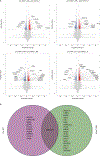Multi-omic Characterization of Pre- and Post-neoadjuvant Chemotherapy Treated Ovarian Cancer Reveals Mediators of Tumorigenesis and Chemotherapy Response
- PMID: 40693832
- PMCID: PMC12377306
- DOI: 10.1158/0008-5472.CAN-24-3804
Multi-omic Characterization of Pre- and Post-neoadjuvant Chemotherapy Treated Ovarian Cancer Reveals Mediators of Tumorigenesis and Chemotherapy Response
Abstract
High-grade serous ovarian cancer (HGSC) accounts for more than 200,000 deaths each year. Despite recent advances in treating HGSC with neoadjuvant chemotherapy, the majority of patients ultimately develop chemotherapy resistance. HGSC is characterized by TP53 mutations and widespread copy number alterations and occurs frequently in the setting of deleterious germline BRCA1/2 variations, but many cases lack putative driver mutations. Here, we performed whole-exome, whole-genome, and whole transcriptome sequencing along with mass spectrometry to characterize the molecular landscape of HGSC in 22 paired samples obtained before and after neoadjuvant chemotherapy. Responsiveness to chemotherapy was determined for each patient. Evidence at the DNA, RNA, and protein level revealed numerous defects in cell-cell and cell-matrix interactions as well as disruption of cell polarity and cytoskeletal regulation in HGSC, indicating that defects in epithelial integrity were present in the majority of HGSC patients. Non-responsive HGSC harbored subclones with putative survival mutations. Additionally, ineffective nonsense mediated decay resulted in the persistence of transcripts with frameshift mutations that were translated into aberrant proteins detectable in HGSC samples. Together, these findings suggest that HGSC may arise through defects in maintenance of epithelial integrity that lead to shedding of malignant cells throughout the peritoneum, and the presence of resistant subclones prior to chemotherapy may decrease the chemosensitivity of patients.
Conflict of interest statement
The authors declare no potential conflicts of interest.
Figures






Similar articles
-
Risk-reducing bilateral salpingo-oophorectomy in women with BRCA1 or BRCA2 mutations.Cochrane Database Syst Rev. 2018 Aug 24;8(8):CD012464. doi: 10.1002/14651858.CD012464.pub2. Cochrane Database Syst Rev. 2018. PMID: 30141832 Free PMC article.
-
Prescription of Controlled Substances: Benefits and Risks.2025 Jul 6. In: StatPearls [Internet]. Treasure Island (FL): StatPearls Publishing; 2025 Jan–. 2025 Jul 6. In: StatPearls [Internet]. Treasure Island (FL): StatPearls Publishing; 2025 Jan–. PMID: 30726003 Free Books & Documents.
-
Impact of residual disease as a prognostic factor for survival in women with advanced epithelial ovarian cancer after primary surgery.Cochrane Database Syst Rev. 2022 Sep 26;9(9):CD015048. doi: 10.1002/14651858.CD015048.pub2. Cochrane Database Syst Rev. 2022. PMID: 36161421 Free PMC article.
-
Taxane monotherapy regimens for the treatment of recurrent epithelial ovarian cancer.Cochrane Database Syst Rev. 2022 Jul 12;7(7):CD008766. doi: 10.1002/14651858.CD008766.pub3. Cochrane Database Syst Rev. 2022. PMID: 35866378 Free PMC article.
-
A rapid and systematic review of the clinical effectiveness and cost-effectiveness of paclitaxel, docetaxel, gemcitabine and vinorelbine in non-small-cell lung cancer.Health Technol Assess. 2001;5(32):1-195. doi: 10.3310/hta5320. Health Technol Assess. 2001. PMID: 12065068
References
Grants and funding
LinkOut - more resources
Full Text Sources
Research Materials
Miscellaneous

